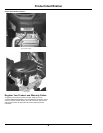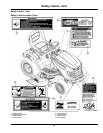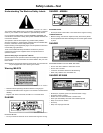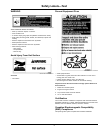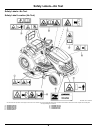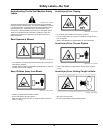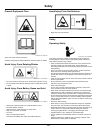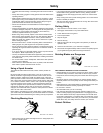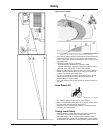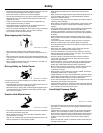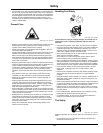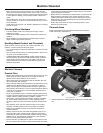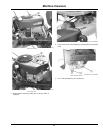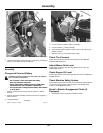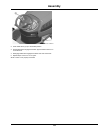
• Death or serious injury can occur when young children associate
having fun with a lawn mowing machine simply because someone has
given them a ride on a machine.
• Children are attracted to lawn mowing machines and mowing
activities. They don’t understand the dangers of rotating blades or the
fact that the operator is unaware of their presence.
• Children who have been given rides in the past may suddenly appear
in the mowing area for another ride and be run over or backed over by
the machine.
• Tragic accidents with children can occur if the operator is not alert to
the presence of children, especially when a child approaches a
machine from behind. Before and while backing up, stop mower
blades and look down and behind the machine carefully, especially for
children.
• Never carry children on a machine or attachment,even with the blades
off. Do not tow children in a cart or trailer. They can fall off and be
seriously injured or interfere with safe machine operation.
• Never use the machine as a recreational vehicle or to entertain
children.
• Never allow children or an untrained person operate the machine.
Instruct all operators not to give children a ride on the machine or in an
attachment.
• Keep children indoors, out of the mowing area, and in the watchful eye
of a responsible adult, other than the operator, when a mower is being
operated.
• Stay alert to the presence of children. Never assume that children will
remain where you last saw them. Turn the machine off if a child enters
the work area.
• Use extreme care when approaching blind corners, shrubs, trees, or
other objects that may block your view of a child.
Operating on Slopes
NOTE: Remove Slope Gauge Template page from the back of this
operators manual. Follow the instructions included with the
template.
• Slopes are a major factor related to loss-of-control and tipover
accidents, which can result in severe injury or death. Operation on all
slopes requires extra caution.
Identify Slopes for Safe Operation
• Follow safe procedures for operation on slopes. Measure slopes of all
moving sites to determine which slopes are safe for mowing with a
ride-on mower. Always use common sense and good judgement when
performing this survey.
Measuring Slopes
• Suggested Method 1: Lay a straight piece of sturdy lumber 1.2 m (4 ft)
long on the slope and measure the angle of the slope with an angle
indicator or protractor level.
• Suggested Method 2: Refer to the slope gauge provided at the end of
this manual.
Operate Safely on Slopes
• Exceeding the recommended maximum slope angle increases the risk
of rollover accidents that can result in serious injury or death.
• Never mow or operate ride-on moweron slope angles greater than 13°
with the lawn ride-on mower in its basic conguration. The basic
conguration is the ride-on mower with mower deck and not other
attachments. (A 13° slope is a slope that rises 1.4 m (4.6 ft) over a
horizontal distance of 6.1 m (20 ft).)
• When using attachments, never mow or operate the ride-on mower on
slope angles greater than 10°. The addition of a weather enclosure,
material collection system, or other attachments will increase the risk
of a rollover. (A 10° slope is a slope that rises 1 m (3.5 ft) over a
horizontal distance of 6.1 m (20 ft).)
• On slope angles of 10° or less, the risk of rollover is low, but as the
slope angle increases to the recommended maximum, the risk
increases to a medium level.
• Always consider potential turf conditions and slope angles when
determining the risk of loss-of-control and tip-over accidents.
• Drive slowly when mowing or operating on slopes.
• If you feel uneasy on a hillside, do not mow or operate on it.
• Mow up and down slopes, not across.
• Watch for holes, ruts, bumps, rocks, or other hidden objects. Uneven
terrain could overturn the ride-on mower. Tall grass can hide
obstacles.
• Drive slowly so you will not have to stop while on a slope.
• Do not mow on wet grass. Tires may lose traction. Tires may slip on
slopes even though the brakes are functioning properly.
• Avoid starting, stopping or turning on a slope. If the tires lose traction,
disengage the PTO and proceed slowly, straight down the slope.
• Keep all movement on slopes slow and gradual. Do not make sudden
changes in speed or direction, which could cause the ride-on mower to
roll over.
Safety
12



